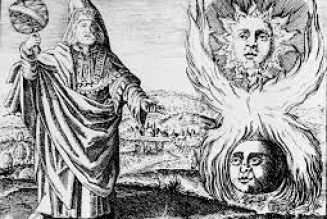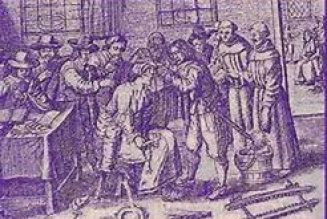Bells are Repellers of witches and evil spirits.
Bells are associated with the divine: their sound is symbolic of creative power, their shape a symbol of the female force and the celestial vault.
The sound vibrations created by the ringing of bells have been believed for centuries to possess magical and/or spiritual power.
Bells are used in many religious rites. In Wicca and Paganism, small handbells may be rung in rituals to enhance harmony and augment power.
In African religions and Vodun, bells and dancing are used to invoke the gods and loas.
Shamans have long used magical bells in their rituals to chase away evil spirits. In folk magic, the ringing of bells drives away evil spirits, witches, and the Devil himself, and wards off the evil eye.
Bells have been attached to clothing, worn as amulets, tied to children and hung from the necks of horses, camels, cows, asses, and other animals important to a community.
As fertility charms, bells have been worn on human phalluses in certain rites.
Bells are sometimes said to have curative powers; medicine is drunk from them. In the Middle Ages, bell ringing was believed to clear the air of disease and was prescribed by some doctors.
Bells also have been used to raise the spirits of the dead and fairies.
Since the fifth century c.e., Christian church bells have been ascribed a special magical potency to combat evil and chase off the wicked spirits that lurked on every church threshold.
In the Middle Ages, on nights when witches were believed to be about, such as Samhain (All Hallow’s Eve) and Beltane (also known as Walpurgisnacht),
church bells were rung to keep the witches from flying over a village.
The townspeople also turned out and added to the noise by banging on pots and pans and ringing their own bells.
In witch trials, accused witches bells 19 testified to being transported through the air to sabbats on the backs of demons or the Devil, and to being thrown off to fall to the ground when a church bell sounded in the night.
Thunder and lightning storms were believed to be the work of witches and demons, and church bells also would be rung at an approaching storm in an attempt to dispel it.
At someone’s death, the tolling of the church bells helped the departing soul on its way to heaven and prevented evil spirits from interfering with the journey.
Church bells were baptized, named for saints, and in some cases, ascribed human characteristics.
Some were said to talk, ring on their own, and sweat blood at the invasion of their community. Medieval Europeans believed that their church bells traveled to Rome on Good Friday; everyone stayed inside so as not to witness their flight from the belfries.
A bell that missed the Good Friday pilgrimage brought bad luck to the community.
Shopkeepers hung bells over their thresholds, not so much to alert them to the entry of customers but to keep evil spirits from entering their premises.
The Necromantic Bell of Giradius.
Bells have been used in rituals for summoning the dead.
One such necromantic bell is that of Giradius. Eighteenth-century French instructions specified that the bell be cast from an alloy of gold, silver, fixed mercury, tin, iron and lead at the exact day and hour of birth of the person who intends to use it.
The bell was to be inscribed with various astrological symbols and the magical words of Adonai, Jesus, and the Tetragrammaton.
The bell was to be wrapped in green taffeta and placed in the middle of a grave in a cemetery.
It was to be left for seven days, during which time it absorbed certain vibrations and emanations.
At the end of a week, the bell was properly “cured” for necromancy rituals.




















